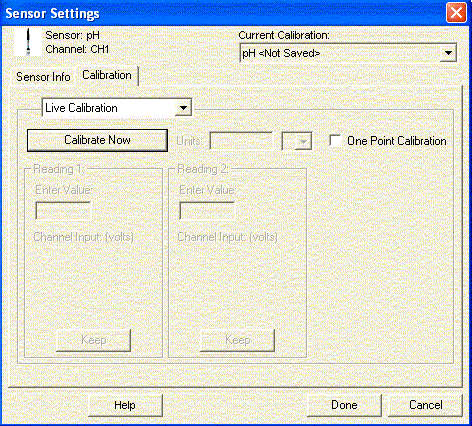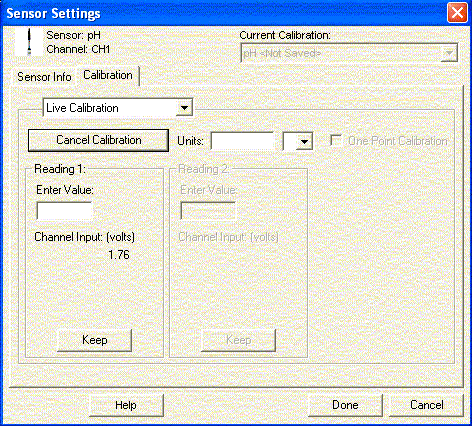pH Measurements with Logger Pro
D. Lamp* and J. M. McCormick
Last Update: February 16, 2009
Set up the Logger Pro A/D converter as described elsewhere with the pH electrode on Channel 1. When the Logger Pro software is started on the computer, the electrode should be automatically detected and the pH will be displayed on the status line in the upper left-hand corner of the window.
If the pH electrode has been stored for more than 24 hours it will be in a storage solution (prepared by dissolving 10.0 g KCl in 100 mL of standard pH 4 buffer). Unscrew the cap on the storage bottle before removing the electrode from the cap and the rubber gasket. Place the storage bottle where it will not be tipped over.
Rinse the electrode with distilled water and pat dry with a Kim Wipe. Be careful not to rub the glass bulb at the electrode’s end. Place the electrode in pH 7 buffer (or the most precise measurements, it is better if this buffer has been freshly-prepared). When the electrode is in the solution, it will be top-heavy. So, be sure that the electrode is secured against tipping.
Before the electrode can be used it must be calibrated. Click on the “pH = ” in the status window in the upper left-hand corner of the window. This will bring up the sensor configuration window shown in Fig. 1. Click on the pH electrode on channel 1 and selectCalibrate from the menu that pops up.

Figure 1. Logger Pro sensor configuration window.
The sensor setting window, shown in Fig. 2, will then be displayed. Live Calibration is the default setting, and should be displayed as in Fig. 2. If you want to do the calibration with only one buffer, select the One Point Calibration check box. If you want to perform the standard two-point calibration, click Calibrate Now.

Figure 2. Logger Pro sensor settings window.
Once you have clicked on the Calibrate Now button, the window will update to that shown in Fig. 3. If the electrode is immersed in standard pH 7 buffer, and the Channel Input: (volts) reading is stable (changes by less than �0.01 V in 30 sec), you can type in 7.00 in the Enter Value: box and click Keep. If you want to use another buffer for the first reading, remove the electrode from its current buffer, rinse copiously with distilled water,pat dry and place it in the new buffer. Once the voltage reading has stabilized, enter the pH of the buffer and click Keep.

Figure 3. Logger Pro sensor settings window after the Calibrate Now button has been pushed.
Once the first buffer’s pH has been entered, remove the electrode from the buffer and rinse it copiously with distilled water. Pat the electrode dry and place it in the new buffer. Wait for the voltage to stabilize and then enter the buffer’s pH in the Enter Value:box under Reading 2. Click Keep and then Done.
The electrode is now calibrated and ready to measure the pH of other solutions. Before transferring the electrode to a new solution, rinse the electrode copiously with distilled water and remove excess water by patting dry.
When you are finished making measurements, the electrode may be stored in the standard pH 7 buffer, if the electrode will be stored for less than 24 hours. If the electrode will not be used again within 24 hours, it should be placed in the pH 4 KCl storage solution.
